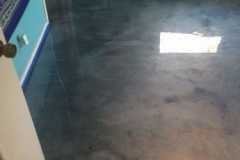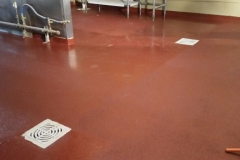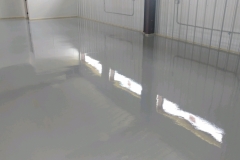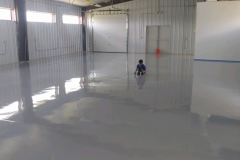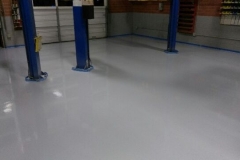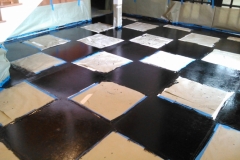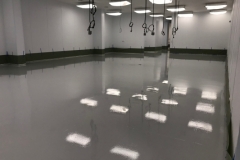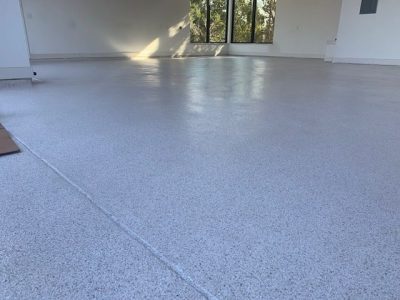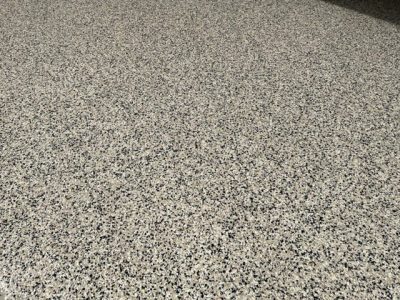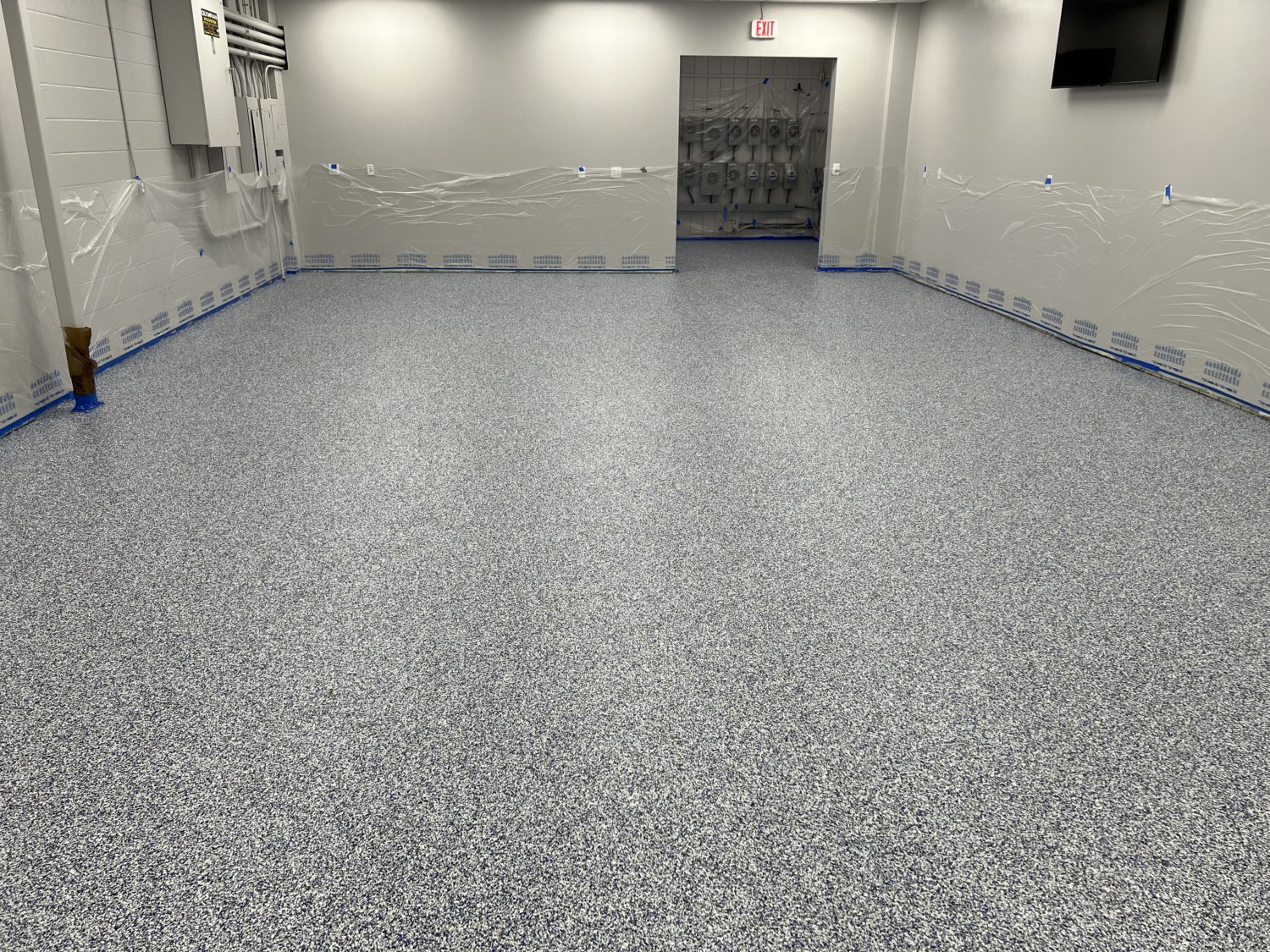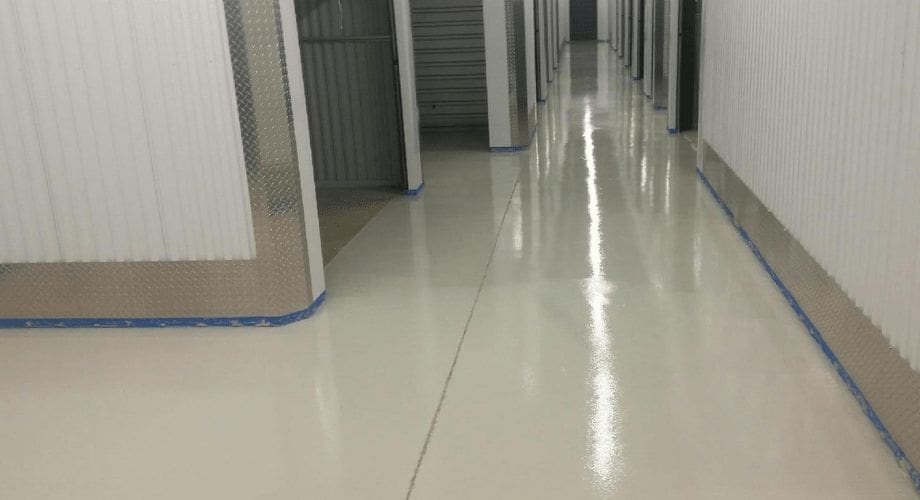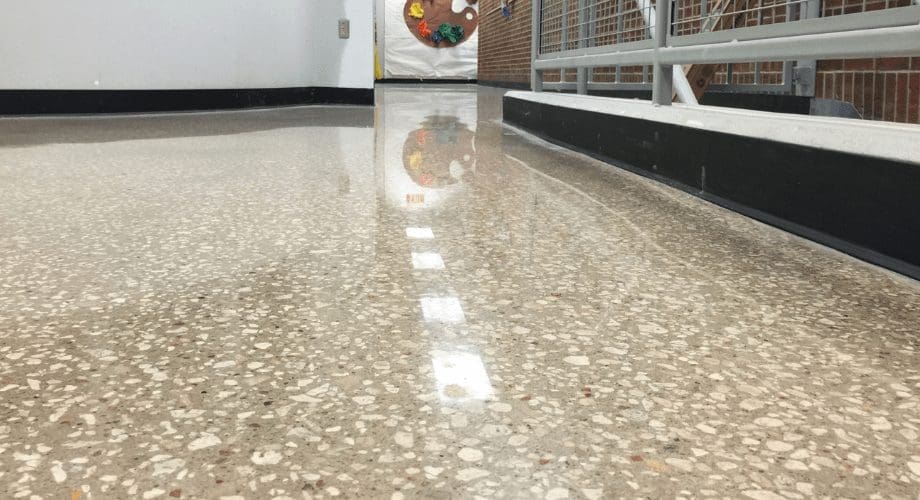Epoxy Floors
Epoxy Flooring and our complete understanding of epoxy floors, resinous coatings, and garage floor epoxy allow our customers to take advantage of our extensive experience with different epoxy floor products to choose the best application for your project. Whether you need a surface appropriate for high-traffic areas, chemically resistant epoxy coatings, simple garage floor paint, textured coatings, or applications featuring intense, bright colors, AllStar Concrete Coatings has just the right epoxy flooring Austin application home and business owners need for a sustainable and stunning final result.
Schedule Consultation
Benefits of Choosing AllStar for Your Epoxy Flooring
- Professional, reliable crews who are committed to delivering superior garage floor epoxy for your space.
- A clean, low-maintenance solution that addresses all your epoxy floor project’s requirements and preferences.
- Access to highly skilled epoxy experts who can recommend design options that will work best for your location.
- A job that is done right, the first time, thanks to industry experts who have the equipment and training to apply these commercial-grade epoxy coatings.
- A truly sustainable flooring alternative that may help you qualify for LEED certification.
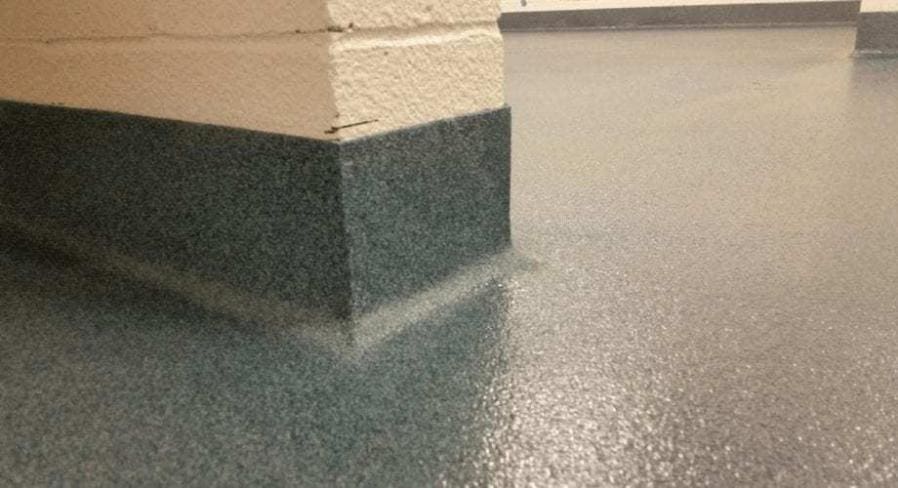
What AllStar Concrete Coatings offers
Epoxy coatings are available in a range of colors, textures, and gloss finishes to enhance your space. AllStar’s expert surface preparation services will correct any imperfections and remove any existing epoxy paint and dirt so you can begin with a strong foundation.
Our pros help you select a particular epoxy flooring system that is tailored for your floor’s intended use. Customers have partnered with us to apply epoxy floors in:
- Manufacturing plants
- Retail epoxy flooring
- Airplane hangar epoxy
- Garage floor epoxy
- Hospitals
- Warehouse epoxy coatings
- Showrooms
- Garage floor paint
The Craftsmen at AllStar Concrete Coatings have a unique combination of in-depth knowledge about the pros and cons of the top industrial and commercial epoxy flooring Austin applications and careful consideration of the smaller details that can often make or break a project. Our customers tell us they are happy they chose epoxy floors because of their:
- Affordability, particularly compared to other types of flooring.
- Durability, as it withstands high amounts of pressure in heavy-traffic areas, including work zones, garage floor epoxy, and industrial settings.
- Longevity can be up to 30 years in residential settings or almost a decade under the most demanding conditions.
- Safety record, since garage floor paint and epoxy coatings are tested for heat, impact, slip, and fire resistance.
- Versatility, with the option to add solid colors or decorative patterns to create a truly unique space.
- Low maintenance requirements and easy-to-clean epoxy flooring surfaces
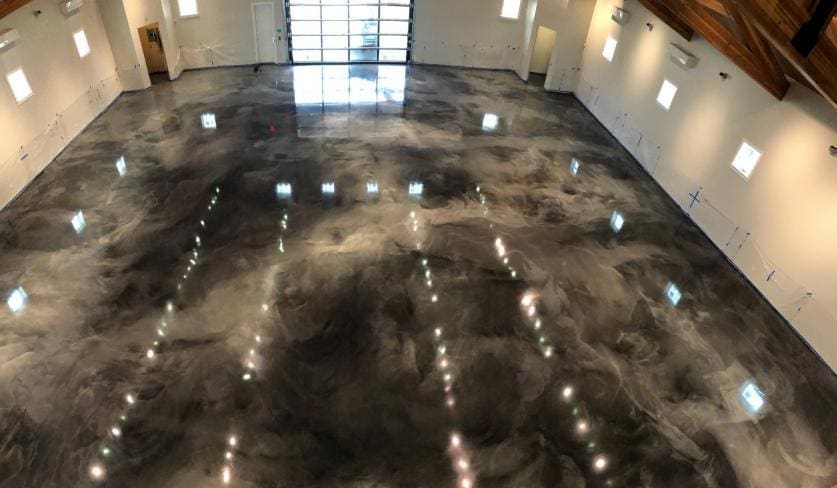
How It Works
Ready to get started? Give us a call or fill out our Schedule Free Consultation form.
Once you tell us more about your project, including your timeline and budget, we can provide you with a free, no-obligation quote.
After you approve our estimate, we will be back in touch to confirm all of the details of your project and to schedule the services, contractors, and equipment you’ll need.
We will coordinate before the start of the project to provide you with the information you’ll need to help us complete the job in the agreed-upon time frame.
These are the typical steps in a resinous flooring project:
- Conduct a thorough assessment of the condition of your existing surfaces.
- Remove all existing concrete sealer or coatings, garage floor paint, stained concrete, dirt, and other surface contaminants to ensure proper adhesion for the coating you have chosen.
- Fill in any control joints or expansion joints.
- If needed, a resinous cove base can be applied.
- Depending on the epoxy flooring system selected for the project, a primer may be applied. A base coat, followed by either a solid or an aggregate broadcast will then be applied, again depending on the project’s scope. Different textures and colors can then be added.
- An epoxy floor finish coat can then be added.
Our project foreman will be available throughout the job to answer any questions you might have and to supervise the contractors doing the work. We will provide all the equipment and can also supply our power (if needed) to get the job finished on time and on budget.
When your floor is complete, we will do a walk-through with you to explain our process and suggest maintenance and care for your new floors.
Introduction to Epoxy Floors
What are Epoxy Floors?
Definition and Basic Composition
Epoxy floors are a type of flooring that involves applying a layer of epoxy resin over a substrate, usually concrete. This resin is a thermosetting polymer, known for its hard, durable, and resistant properties. The basic composition of epoxy flooring involves a two-part system: a resin and a hardener. When mixed, these components chemically react to form a rigid plastic material that bonds exceptionally well to most base layers. This section will detail the chemical makeup of epoxy resins, the process of mixing and curing, and how this results in flooring that’s not just visually appealing but also extremely resilient and long-lasting. The discussion can include various additives that can be included in the mixture, such as colorants, flakes, or other decorative elements, as well as functional additives that can enhance the floor’s properties, like slip resistance or antimicrobial agents.
History and Evolution of Epoxy Flooring
The history and evolution of epoxy flooring showcase its journey from industrial applications to widespread commercial and residential use. Initially developed for use in heavy-duty environments due to its toughness and durability, epoxy flooring has evolved in terms of technology, application methods, and aesthetic options. This section will cover the milestones in the development of epoxy flooring solutions, from its inception in industrial settings to its modern-day use in homes, offices, and various industries. It would also highlight the advancements in epoxy technology, such as UV-resistant formulas, faster curing times, and an expanded range of finishes and textures that cater to a broader spectrum of aesthetic preferences and functional requirements.
Importance of Epoxy Floors in Modern Construction
Epoxy flooring has become increasingly significant in modern construction due to its unique blend of aesthetic appeal, durability, and cost-effectiveness. This section will delve into the reasons behind the growing preference for epoxy floors in various sectors, including residential, commercial, and industrial construction.
Unmatched Durability and Resilience
Epoxy flooring is renowned for its strength and longevity. It can withstand heavy traffic, impacts, stains, and spills, making it an ideal choice for garages, warehouses, and manufacturing plants. This section will discuss how the tough, protective layer that epoxy flooring provides helps preserve the underlying concrete and reduces the need for frequent repairs and maintenance.
Safety and Hygiene
Safety is paramount in any construction, and epoxy floors contribute significantly by offering slip-resistant and fire-resistant options. Additionally, their seamless and impervious surface does not harbor bacteria or dust, making them an excellent choice for healthcare facilities, food processing plants, and pharmaceutical industries. This part will explore the safety features of epoxy flooring and how it meets the strict standards of industries that prioritize hygiene and cleanliness.
Aesthetic Flexibility
Epoxy floors are not just about functionality. They offer a wide range of colors, patterns, and textures that can transform a plain floor into a work of art. This section will highlight how the versatility of epoxy flooring makes it a popular choice for showrooms, retail spaces, and residential areas, where the floor can be customized to reflect a brand’s identity or a homeowner’s style.
Environmental Impact
The sustainability factor of epoxy floors is an essential aspect of modern construction. Epoxy flooring is often preferred for its eco-friendly options, such as low VOC (volatile organic compounds) emissions and long lifespan, which reduce the need for frequent replacements and, consequently, the environmental impact. This subsection will discuss the benefits of choosing epoxy flooring from an ecological perspective and how it contributes to green building certifications.
Cost-Effectiveness and Easy Maintenance
In the context of modern construction, budget and ease of maintenance are crucial considerations. Epoxy floors offer a high return on investment due to their durability and low lifecycle costs. They are easy to clean and require minimal upkeep, and their longevity means that the costs of replacement and repair are significantly reduced over time. This section will elaborate on the economic benefits of epoxy flooring, considering both the initial installation cost and the long-term savings.
Schedule ConsultationTypes of Epoxy Flooring
Self-Leveling Epoxy Floors
Self-leveling epoxy floors are a specific type of epoxy flooring system that is highly sought after for its ability to create a smooth, seamless, and durable surface. This section will discuss the advantages of self-leveling epoxy floors and their ideal use cases in various settings.
Benefits of Self-Leveling Epoxy Floors
Smooth and Seamless Finish
Self-leveling epoxy floors are highly sought after for their remarkable ability to provide a smooth and seamless finish. This notable feature is particularly beneficial in transforming old, cracked, or uneven floors into aesthetically pleasing and functional surfaces.
- Transformative Quality: Self-leveling epoxy is known for its excellent flow characteristics, which allow it to spread evenly over the substrate. Self-leveling epoxy fills in cracks, holes, and other surface imperfections, effectively creating a smooth and level finish.
- Professional Appearance: The flawless surface achieved with self-leveling epoxy not only enhances the appearance of the floor but also contributes to a more professional and high-quality look for the space. This part will highlight the visual benefits of a seamless finish, free from blemishes and irregularities, which is particularly important in commercial and public spaces where aesthetics play a crucial role.
- Uniform Thickness: Unlike traditional flooring options, self-leveling epoxy provides a consistent thickness across the entire floor area. The self-leveling nature of the material ensures an even application, resulting in a uniform surface that enhances both the functionality and the visual appeal of the floor.
- Enhanced Reflectivity: The smooth and seamless finish of self-leveling epoxy floors can also improve the reflectivity of the surface. The glossy finish not only adds to the aesthetic but also maximizes the natural and artificial light in the space, contributing to a brighter and more inviting atmosphere.
High Strength and Durability
Self-leveling epoxy floors are renowned for their robustness and long-lasting performance, making them a preferred choice for areas subjected to intense use. The intrinsic properties of self-leveling epoxy contribute significantly to its ability to withstand various forms of stress.
- Robust Composition: At the core of its strength, the chemical composition of self-leveling epoxy is designed for toughness. This part will delve into the specific components of the epoxy resin and hardener, explaining how their chemical reaction creates a solid, cohesive material known for its exceptional structural integrity.
- Resistance to Wear and Tear: One of the most compelling attributes of self-leveling epoxy floors is their ability to resist scratches, abrasions, and general wear. This subsection will highlight the resilience of the epoxy surface when faced with heavy foot traffic and the movement of machinery, underscoring its suitability for high-traffic areas.
- Withstanding Heavy Loads: In industrial settings, floors must support the weight of heavy machinery and equipment. This part will discuss the load-bearing capabilities of self-leveling epoxy, emphasizing its ability to maintain structural integrity under significant weight without cracking or deforming.
- Chemical Spill Resistance: Exposure to chemicals is a common concern in many commercial and industrial environments. Self-leveling epoxy floors are impermeable and resistant to a wide range of chemicals, including acids, solvents, and alkalis. This subsection will explore how this resistance contributes to the longevity of the flooring, preventing damage and deterioration that can be caused by chemical spills or splashes.
- Longevity and Lifecycle: Beyond its immediate resistance to physical and chemical stresses, self-leveling epoxy flooring is also notable for its overall lifespan. This part will discuss the long-term durability of epoxy floors, noting how their resilience translates to fewer repairs and replacements over time, ultimately offering a cost-effective flooring solution in terms of lifecycle costs.
Easy Maintenance and Hygiene
Self-leveling epoxy floors are highly valued in settings where cleanliness and hygiene are top priorities, thanks to their seamless finish and easy-to-clean nature.
- Seamless and Smooth Surface: The lack of joints, seams, or crevices in self-leveling epoxy floors is a significant hygienic advantage. This subsection will discuss how the seamless nature of these floors eliminates spaces where dirt, bacteria, or mold could otherwise hide and proliferate, ensuring a cleaner and more sanitary environment.
- Simplified Cleaning Process: The smooth surface of self-leveling epoxy floors makes cleaning a straightforward task. This part will highlight the ease of maintaining these floors, involving regular sweeping and mopping, and how they can be kept hygienic with minimal effort. The resistance of epoxy floors to water and common cleaning agents will also be discussed, emphasizing their compatibility with standard cleaning routines and disinfection procedures.
- Resistance to Stains and Spills: Epoxy flooring is impervious to most stains and spills, which can be wiped away without leaving a residue. This subsection will explore how this resistance to staining contributes to the overall hygiene of the space, as spills can be quickly addressed without the risk of lingering bacteria or odors.
- Suitability for Sensitive Environments: In environments like healthcare facilities, food processing plants, and pharmaceutical labs, the cleanliness of the flooring is crucial. This part will discuss the specific advantages of self-leveling epoxy floors in these settings, such as their compatibility with strict sanitation protocols and their contribution to maintaining a sterile environment, preventing cross-contamination, and ensuring compliance with industry regulations.
- Long-Term Hygienic Performance: Beyond the immediate ease of cleaning, self-leveling epoxy floors offer long-term hygienic benefits. This subsection will cover the durability of the hygienic properties of epoxy floors, noting how their resistance to wear and chemicals ensures that the floors remain easy to clean and sanitize throughout their lifespan.
Aesthetic Versatility
Self-leveling epoxy floors are not only practical but also highly versatile in terms of design, offering a myriad of aesthetic possibilities to complement any interior style.
- Rich Array of Color Options: One of the standout features of self-leveling epoxy floors is the extensive color palette available. This subsection will explore the vast range of hues, from vibrant and bold to subtle and understated, allowing for the creation of flooring that perfectly aligns with the desired ambiance of a space.
- Intricate Patterns and Designs: Beyond solid colors, self-leveling epoxy floors can be enhanced with patterns, designs, or even metallic effects. This part will discuss how these design elements can be integrated into the flooring, transforming a plain surface into a stunning focal point of the room.
- Customization at Its Best: The true beauty of self-leveling epoxy flooring lies in its customization potential. This subsection will highlight how individuals can tailor their floors to reflect their unique style or brand identity, whether through custom color mixes, decorative chips, or incorporating logos and graphics directly into the floor.
- Sophistication and Elegance: For spaces that require a touch of elegance, self-leveling epoxy floors can deliver a high-end look. This part will discuss the luxurious finishes that can be achieved with epoxy, such as high-gloss or metallic finishes, elevating the aesthetic of any commercial, residential, or industrial setting.
- Harmony with Interior Décor: The adaptability of self-leveling epoxy floors makes them an excellent choice for achieving design cohesion. This subsection will explain how the flooring can be tailored to complement or contrast with the other design elements in a space, contributing to a harmonious and well-thought-out interior.
Ideal Use-Cases for Self-Leveling Epoxy Floors
Industrial and Manufacturing Facilities
Self-leveling epoxy floors excel in industrial and manufacturing environments where floors must endure heavy use and challenging conditions.
- Handling Heavy Loads: In facilities where heavy machinery, equipment, and constant movement are the norms, self-leveling epoxy floors prove their worth. This part will discuss the floor’s capacity to support substantial weight and resist damage from industrial operations, ensuring the floor’s surface remains intact and functional under rigorous conditions.
- Resilience Against Wear and Tear: The day-to-day operations in industrial settings can take a toll on flooring. This subsection will emphasize the durability of self-leveling epoxy floors, highlighting their resistance to abrasions, impacts, and continuous foot traffic, which keeps them in prime condition for longer periods compared to traditional flooring options.
- Low-Maintenance Requirements: Maintenance downtime can disrupt industrial operations. Self-leveling epoxy floors offer a solution with their easy-to-clean surface and minimal upkeep needs. This part will detail the straightforward cleaning process and the floor’s ability to maintain its appearance and performance with minimal maintenance, making it a cost-effective and efficient choice for busy industrial settings.
- Safety and Compliance: Safety is paramount in industrial environments. This subsection will cover the safety features of self-leveling epoxy floors, such as their potential for slip resistance and their contribution to creating a safer work environment. It will also touch upon how these floors can be customized with safety markings and signs, contributing to compliance with workplace safety standards.
- Chemical and Stain Resistance: Exposure to chemicals, oils, and solvents is common in manufacturing facilities. This part will discuss the chemical-resistant properties of self-leveling epoxy floors, explaining how they resist staining and damage from chemical spills, thereby preserving the integrity and appearance of the flooring in environments where chemical exposure is a regular occurrence.
Healthcare and Pharmaceutical Industries
In the healthcare and pharmaceutical sectors, maintaining a sterile environment is non-negotiable. Self-leveling epoxy floors serve as a frontline defense in these settings, offering superior hygiene and ease of maintenance.
- Promoting Sterile Conditions: The seamless and smooth surface of self-leveling epoxy floors leaves no room for bacteria, mold, or pathogens to hide and multiply. This subsection will explain how the non-porous nature of these floors supports rigorous hygiene protocols, making them an indispensable element in areas that demand absolute cleanliness.
- Ease of Sanitization: Frequent and thorough cleaning is a standard practice in medical and pharmaceutical environments. This part will highlight the ease with which epoxy floors can be sanitized, resisting the harsh disinfectants and cleaners necessary to maintain sterile conditions. It will discuss how the durability of the floor’s surface ensures that it remains intact and effective, even with regular exposure to intensive cleaning routines.
- Chemical and Spill Resistance: Handling potent chemicals and substances is commonplace in healthcare and pharmaceutical settings. This subsection will cover the chemical-resistant properties of self-leveling epoxy floors, emphasizing their ability to withstand spills and prevent contamination. The quick and easy cleanup of spills on epoxy floors further contributes to maintaining an uncontaminated environment.
- Contributing to a Safe Environment: The safety of patients and staff is paramount. This part will discuss the optional slip-resistant finishes available with self-leveling epoxy flooring, reducing the risk of slips and falls. It will also touch upon the floor’s contribution to better indoor air quality, as epoxy flooring does not harbor allergens or dust.
- Design and Functionality: While functionality is the priority, the aesthetic aspect cannot be ignored, especially in public-facing areas like hospital lobbies or pharmacies. This subsection will illustrate how the design versatility of self-leveling epoxy floors allows them to blend seamlessly with the facility’s aesthetics, creating a welcoming atmosphere without compromising on hygiene or safety.
Educational and Institutional Buildings
Educational facilities, from primary schools to universities, require flooring that can withstand the unique demands of a learning environment while maintaining a welcoming and conducive atmosphere for education. Self-leveling epoxy floors are increasingly recognized as a fitting choice for these institutions due to their durability, ease of maintenance, and aesthetic versatility.
- Withstanding Daily Wear and Tear: Educational institutions are hubs of activity, with high foot traffic, frequent movement of furniture, and the inevitable spills and stains. This subsection will discuss the robustness of self-leveling epoxy floors, emphasizing their ability to resist wear, abrasions, and damage, thereby maintaining a neat and functional appearance over time.
- Low Maintenance Requirements: The ease of cleaning and low maintenance needs of self-leveling epoxy floors are particularly beneficial in educational settings where resources and time for upkeep may be limited. This part will highlight the straightforward cleaning process for epoxy floors and how their resistance to stains and spills makes them an ideal choice for busy, high-traffic learning environments.
- Creating a Positive Learning Environment: The aesthetics of an educational space can significantly impact the learning experience. This subsection will explore the range of colors and finishes available with self-leveling epoxy flooring, allowing institutions to create bright, vibrant, or calming environments conducive to learning and creativity.
- Safety Considerations: Safety is a top priority in educational settings. This part will discuss the safety features of self-leveling epoxy floors, such as their potential for slip resistance and the option for clearly marked walkways or designated areas, contributing to a safer environment for students and staff.
- Cost-Effectiveness and Long-Term Value: Budget considerations are crucial for educational institutions. Self-leveling epoxy floors offer a cost-effective flooring solution due to their longevity and minimal upkeep requirements. This subsection will analyze the long-term financial benefits of epoxy flooring, considering the reduced need for frequent repairs or replacements and the enduring value it provides to educational facilities.
Epoxy Mortar Floors
Epoxy mortar floors are the epitome of strength and durability in the epoxy flooring family. Known for their robustness, these floors consist of 100% solid epoxies mixed with graded sand or quartz sand and are used in some of the most demanding industrial environments. This section will delve into the standout features of epoxy mortar floors—their unmatched durability—and discuss their industrial applications.
Durability of Epoxy Mortar Floors
Exceptional Strength and Impact Resistance
Epoxy mortar floors are a testament to engineering excellence, known for their superior strength and ability to withstand extreme conditions. This part will delve into the unique properties that make epoxy mortar floors a robust choice for challenging environments.
- Resistance to Heavy Impact: In settings where floors are subjected to constant heavy loads, epoxy mortar floors stand out for their ability to absorb and dissipate impact. This subsection will describe how the dense and cohesive nature of these floors allows them to withstand heavy machinery, equipment drops, and other high-impact events without showing signs of damage.
- Endurance Against Thermal Shock: Epoxy mortar floors are not just mechanically strong; they also resist thermal stress remarkably well. This part will explore the thermal resilience of epoxy mortar floors, explaining how their composition allows them to withstand rapid temperature changes, such as those experienced in industrial processes, without cracking or degrading.
- Formidable Chemical Resistance: Exposure to harsh chemicals is a common challenge in many industrial settings. Epoxy mortar floors excel in this aspect as well. This subsection will break down the chemical resistance properties of these floors, discussing how the combination of 100% solid epoxy and graded aggregates creates a barrier that is impervious to a wide range of chemical spills, including acids, alkalis, and solvents.
- Composition and Structure: The backbone of the strength and resistance of epoxy mortar floors lies in their composition. This part will provide an in-depth look at the blend of 100% solid epoxy and graded aggregates, explaining how this combination results in a high-density, tightly cross-linked matrix that offers exceptional durability and longevity.
Crack and Damage Repair Capabilities
Epoxy mortar floors are not just about surface-level appeal; they bring robust restorative capabilities to the table. This unique feature sets them apart, providing a dual function of protection and repair that extends the life of existing flooring.
- Mending Cracks with Precision: Epoxy mortar is especially adept at filling in cracks and fissures in concrete floors. This subsection will describe the process of penetrating into the smallest of crevices, effectively bonding with the old material, and creating a seamless repair that restores the floor’s appearance and structural stability.
- Revitalizing Damaged Surfaces: Beyond simple crack repair, epoxy mortar can address more extensive surface damage. This part will detail how epoxy mortar, with its thick, paste-like consistency, can be used to level out uneven surfaces, fill in holes, and rectify other forms of surface damage, rejuvenating the floor and preparing it for years of future use.
- Enhancing Structural Integrity: Epoxy mortar does more than just cover up blemishes; it integrates with the existing substrate to enhance its strength. This subsection will discuss how the bonding process of epoxy mortar not only repairs but also reinforces the floor, increasing its load-bearing capacity and resistance to future damage.
- Protective Layer against Further Damage: Once applied, epoxy mortar acts as a formidable barrier against wear, impact, and chemical exposure. This part will highlight the protective qualities of epoxy mortar floors, explaining how they shield the underlying surface from future damage and reduce the need for frequent repairs.
Longevity and Low Maintenance
Epoxy mortar floors are synonymous with longevity and ease of upkeep, characteristics that are particularly valued in settings where the flooring needs to perform under challenging conditions over extended periods.
- Built to Last: The robust construction of epoxy mortar floors is a cornerstone of their appeal in industrial settings. This part will discuss the inherent durability of these floors, emphasizing their ability to endure constant heavy traffic, resist pressure from heavy machinery, and withstand harsh environmental conditions without deteriorating, ensuring a long service life and exceptional performance.
- Resilience Against Wear and Tear: Epoxy mortar floors are not easily fazed by the daily rigors of industrial activity. This subsection will highlight their resistance to abrasions, impacts, and continuous use, maintaining their structural integrity and appearance over time, which is crucial in preserving the operational efficiency and safety of industrial environments.
- Minimal Maintenance Demands: One of the most compelling aspects of epoxy mortar floors is their low maintenance requirement. This part will detail the straightforward cleaning process, the infrequent need for repairs, and the overall ease of upkeep. It will also discuss how these floors resist staining and are impervious to most chemicals, making them easy to maintain and keep in pristine condition with minimal effort.
- Long-Term Cost Efficiency: While the initial investment in epoxy mortar flooring might be higher than some alternatives, the long-term savings are substantial. This subsection will analyze the cost-effectiveness of epoxy mortar floors, taking into account their extended lifespan, minimal maintenance needs, and reduced likelihood of needing frequent repairs or replacements.
Industrial Applications of Epoxy Mortar Floors
Manufacturing and Warehousing
Epoxy mortar floors are a standout solution in the manufacturing and warehousing sectors, where flooring is subjected to extreme operational demands and must maintain its integrity under challenging conditions.
- Supporting Heavy Machinery: The industrial arena is home to heavy machinery and equipment, which places immense stress on flooring. This subsection will explore how epoxy mortar floors are uniquely equipped to support the weight and movement of such machinery without succumbing to stress, cracks, or structural failure.
- Withstanding Frequent Loading and Unloading: The dynamic nature of manufacturing and warehousing involves constant loading and unloading activities, a process that can be taxing on floors. This part will discuss the resilience of epoxy mortar floors to these activities, highlighting their ability to resist damage from frequent and heavy movement, thereby ensuring a continuously safe and functional workspace.
- Managing Constant Traffic: Foot traffic and the movement of trolleys, forklifts, and other vehicles are constant in these environments. This subsection will detail the ability of epoxy mortar floors to withstand this non-stop traffic, maintaining their structural integrity and appearance over time, a crucial factor in maintaining operational efficiency and safety.
- Resisting Cracking and Peeling: Under the heavy use typical in manufacturing and warehousing, flooring is often prone to cracking, peeling, or other forms of wear. This part will emphasize the superior composition of epoxy mortar floors, which ensures they remain intact and performative, resisting the common pitfalls that can plague less robust flooring solutions.
Chemical and Pharmaceutical Industries
In the realms of chemical processing and pharmaceutical manufacturing, where the handling of corrosive substances is routine, the integrity of the flooring is of paramount importance. Epoxy mortar floors emerge as a superior choice in these industries due to their exceptional chemical resistance and robustness.
- Resilience to Corrosive Substances: The chemical industry frequently deals with substances that can be highly corrosive, posing a threat to standard flooring materials. This subsection will discuss the chemical-resistant properties of epoxy mortar floors, highlighting their ability to withstand exposure to a wide range of corrosive agents, from strong acids and alkalis to organic solvents, without deteriorating or losing their structural integrity.
- Maintaining a Contaminant-Free Environment: In pharmaceutical manufacturing, maintaining an uncontaminated environment is crucial. This part will explore how the non-porous nature of epoxy mortar floors prevents the absorption of spillages, thereby mitigating the risk of contamination. It will also discuss how the seamless finish of these floors leaves no space for bacteria or contaminants to hide, supporting the stringent hygiene standards required in pharmaceutical settings.
- Durability in Rigorous Environments: Chemical and pharmaceutical plants are environments where flooring must endure not just chemical exposure but also heavy equipment and constant foot traffic. This subsection will detail the robust construction of epoxy mortar floors, emphasizing their ability to withstand these multiple forms of stress, ensuring a long-lasting, safe, and functional flooring solution.
- Ease of Decontamination and Cleaning: The ability to effectively clean and decontaminate the floor is essential in chemical and pharmaceutical industries. This part will highlight the ease with which epoxy mortar floors can be cleaned and decontaminated, owing to their smooth, non-porous surface that does not allow substances to penetrate or persist, thereby facilitating stringent cleaning protocols.
Food and Beverage Processing
In the food and beverage industry, where hygiene is a top priority and the environment can be challenging, the choice of flooring is critical. Epoxy mortar floors are highly valued in this sector for their ability to meet stringent hygiene standards and withstand the unique demands of food processing environments.
- Upholding Hygiene Standards: Maintaining an immaculate environment is essential in food and beverage processing to prevent contamination and ensure product safety. This subsection will discuss the hygienic properties of epoxy mortar floors, focusing on their seamless, non-porous surface that leaves no space for bacteria, mold, or other pathogens to thrive, thereby supporting the industry’s rigorous cleanliness requirements.
- Withstanding Thermal Shocks: Processing food and beverages often involves extreme temperature changes, which can be damaging to many flooring materials. This part will explore the thermal shock resistance of epoxy mortar floors, explaining how they withstand sudden temperature fluctuations — common during processes like steam cleaning or cold storage — without cracking or losing their integrity.
- Resisting Frequent Washdowns: The frequent cleaning and sanitizing required in food and beverage processing facilities necessitate a floor that can endure constant exposure to water and cleaning agents. This subsection will highlight the water-resistant nature of epoxy mortar floors and their ability to withstand harsh cleaning routines without deteriorating, ensuring a long-lasting and hygienic flooring solution.
- Preventing Bacterial Growth: In an industry where even a small amount of bacterial contamination can have significant repercussions, the antibacterial properties of epoxy mortar floors are particularly beneficial. This part will discuss how the smooth, impervious surface of these floors not only makes cleaning more effective but also hinders microbial growth, contributing to a safer food processing environment.
- Ease of Cleaning and Maintenance: Ensuring that floors remain hygienic with minimal downtime is crucial in the fast-paced food and beverage industry. This subsection will cover the ease with which epoxy mortar floors can be cleaned and maintained, noting how their resistance to staining and abrasion allows for efficient cleaning processes, ultimately contributing to the facility’s overall operational efficiency.
Automotive and Mechanical Industries
In the automotive and mechanical sectors, floors are subjected to harsh conditions, including exposure to oils, lubricants, and the constant movement of vehicles and heavy equipment. Epoxy mortar floors are highly regarded in these industries for their robustness and their ability to maintain performance in such demanding environments.
- Resistance to Oil and Chemical Spills: Workspaces in the automotive and mechanical industries are prone to spills of oils, lubricants, and various chemicals. This subsection will discuss the chemical-resistant properties of epoxy mortar floors, emphasizing their ability to resist damage from such spills, prevent staining, and ensure easy cleanup, thereby maintaining a safe and functional workspace.
- Durability Under Heavy Traffic: The frequent movement of vehicles, forklifts, and heavy machinery is a daily occurrence in these industries. This part will highlight the exceptional load-bearing capacity of epoxy mortar floors, focusing on their ability to withstand heavy vehicular traffic without cracking, buckling, or showing signs of wear.
- Slip-Resistant Surface for Safety: Safety is a paramount concern in any industry, and the automotive and mechanical sectors are no exception. This subsection will explore the slip-resistant options available with epoxy mortar flooring, detailing how these floors can be customized to provide a safe, non-slip surface, reducing the risk of accidents in workplaces where spills and slick surfaces are common.
- Long-Term Performance and Reliability: Facilities in the automotive and mechanical industries require flooring solutions that are not just durable but also long-lasting. This part will discuss the longevity of epoxy mortar floors, emphasizing their ability to maintain their structural integrity and appearance over time, even in the face of rigorous industrial use, thereby offering a reliable and cost-effective flooring solution.
- Ease of Maintenance for Operational Efficiency: Minimizing downtime for maintenance is crucial to maintaining productivity in these industries. This subsection will cover the low maintenance needs of epoxy mortar floors, highlighting how their seamless surface allows for quick and effective cleaning, ensuring that the facility can maintain high operational efficiency and a professional appearance.
Quartz-Filled Epoxy Floors
Quartz-filled epoxy floors combine the durability of epoxy with the aesthetic appeal of colored quartz granules. They offer a decorative yet functional flooring solution, perfect for areas that demand visual appeal along with flooring performance. This section will explore the aesthetic aspects of quartz-filled epoxy floors and their versatile usage in various settings.
Aesthetic Appeal of Quartz-Filled Epoxy Floors
Vibrant and Customizable Designs
- Quartz-filled epoxy floors are known for their wide range of colors and patterns. This subsection will discuss how the incorporation of colored quartz granules into the epoxy matrix allows for a multitude of design options, enabling custom floor designs that can complement any interior decor or branding requirements.
Seamless and Reflective Surface
- The seamless nature of quartz-filled epoxy floors not only contributes to their hygienic properties but also enhances their visual appeal. This part will detail the smooth, glossy finish of these floors, which reflects light and adds a sense of space and brightness to any room.
Texture and Slip Resistance
- While quartz-filled epoxy floors are aesthetically pleasing, they also offer practical benefits. This subsection will explore how the texture of the quartz granules provides slip resistance, making these floors not just attractive but also safe for areas with high foot traffic.
Usage of Quartz-Filled Epoxy Floors
Commercial and Retail Spaces
- Quartz-filled epoxy floors are an excellent choice for commercial settings where appearance is crucial, such as retail stores, showrooms, and lobbies. This subsection will discuss how these floors withstand high foot traffic while maintaining their aesthetic appeal, making a strong first impression on customers and visitors.
Healthcare and Educational Facilities
- In settings where hygiene is a priority, but aesthetics cannot be compromised, quartz-filled epoxy floors offer the perfect solution. This part will cover the application of these floors in hospitals, clinics, and schools, emphasizing their easy maintenance, durability, and contribution to creating a welcoming environment.
Hospitality and Recreational Venues
- The hospitality industry, including hotels, restaurants, and recreational facilities, requires flooring that is both attractive and capable of withstanding constant use. This subsection will highlight how quartz-filled epoxy floors meet these needs, providing a durable, easy-to-clean surface that enhances the overall aesthetic of these venues.
Residential Spaces
- Quartz-filled epoxy floors are also making their way into residential spaces, particularly in areas like kitchens, garages, and basements. This part will discuss the benefits of these floors for homeowners, including their longevity, ease of maintenance, and the value they add to the property through their attractive appearance.
Anti-Static Epoxy Floors (ESD Resistant)
Anti-static epoxy floors, also known as Electrostatic Dissipative (ESD) floors, are specially formulated to prevent static electricity buildup, a crucial feature in environments where even a small electric discharge can have significant consequences. This section will explore the critical role of anti-static epoxy floors in industries sensitive to electrostatic discharge, such as electronics and pharmaceuticals.
Understanding Anti-Static Epoxy Floors
Mechanism of ESD Prevention
This subsection will explain the science behind anti-static epoxy floors, detailing how they are designed to control static electricity. It will discuss the materials used in these floors, such as conductive compounds, which allow electrical charges to dissipate safely, preventing the accumulation of static electricity.
Installation and Maintenance
- Installing anti-static epoxy floors requires precision and expertise to ensure they perform as intended. This part will outline the installation process, including the grounding methods used to ensure proper dissipation of electrical charges. It will also cover maintenance practices that preserve the floor’s anti-static properties over time.
Importance in Electronics and Pharmaceuticals Industries
Electronics Industry
- In the electronics industry, static electricity can damage sensitive components, leading to product failures and significant financial losses. This subsection will discuss how anti-static epoxy floors are essential in manufacturing, assembly, and testing areas, protecting electronic components from ESD and ensuring product reliability and safety.
Pharmaceuticals Industry
- In pharmaceutical manufacturing, ESD can not only damage sensitive equipment but also pose risks in environments where flammable materials are handled. This part will explore how anti-static epoxy floors contribute to creating a safe environment by preventing static sparks that could lead to fires or explosions, ensuring compliance with strict industry regulations and safety standards.
Cleanrooms and Laboratories
- Cleanrooms and laboratories require controlled environments where ESD can compromise the integrity of experiments and production processes. This subsection will highlight the role of anti-static epoxy floors in maintaining the integrity of these controlled environments, preventing static buildup, and ensuring the accuracy and reliability of sensitive work conducted in these spaces.
Epoxy Garage Floor
Flake epoxy floors are a popular choice for spaces that require a decorative touch along with the functional benefits of epoxy. These floors consist of a base layer of epoxy resin into which colored flakes or chips are added, providing a unique aesthetic appeal and additional texture. This section will delve into the decorative aspects of flake epoxy floors and the various customization options available.
Decorative Aspects of Flake Epoxy Floors
Varied Color and Texture Choices
- Flake epoxy floors offer a wide array of color options and flake sizes, allowing for a multitude of design possibilities. This subsection will discuss how the combination of base epoxy colors with colored flakes can be tailored to match any décor, branding, or thematic requirements, making each floor uniquely appealing.
Enhancing Visual Depth and Interest
- The inclusion of flakes in the epoxy not only adds color but also depth and texture to the flooring. This part will elaborate on how the reflective properties of the flakes and their random distribution create a dynamic, three-dimensional appearance that enhances the overall look of the space.
Custom Blend Options
- For those seeking a truly personalized flooring solution, custom blends of flakes can be created. This subsection will explore the opportunity for clients to mix and match flake colors, sizes, and densities to create a bespoke floor that perfectly fits their vision and space.
Customization Options for Flake Epoxy Floors
Tailoring to Space Usage
- The versatility of flake epoxy flooring allows it to be customized not just in appearance but also in functionality. This part will discuss how the texture and finish of the floor can be adapted based on the specific needs of the space, such as enhancing slip resistance in high-traffic areas or ensuring ease of cleaning in commercial settings.
Logo and Pattern Incorporation
- Flake epoxy floors can also be used as a canvas to display logos, patterns, or wayfinding elements within the flooring. This subsection will highlight how businesses and institutions can incorporate branding directly into their floors, enhancing the aesthetic appeal and making a memorable impression on visitors.
Seamless Integration with Overall Design
- The customization options of flake epoxy floors make them an ideal choice for projects where the flooring needs to complement or enhance the overall design scheme. This part will emphasize how these floors can be integrated seamlessly with other design elements, contributing to a cohesive and well-thought-out interior.
Benefits of Epoxy Floors
Epoxy floors are renowned for their exceptional benefits, key among them being their durability and longevity. This section will discuss these crucial advantages in detail, setting epoxy flooring apart from other types of flooring options available in the market.
Durability and Longevity
Epoxy flooring systems offer an unbeatable combination of durability and longevity, making them a cost-effective and reliable choice for both industrial and residential applications.
Comparison with Other Flooring Types
Superior Resistance to Wear and Tear
- Epoxy floors are known for their resistance to high levels of wear and tear, a feature that is paramount in settings with heavy foot traffic or machinery. This subsection will compare epoxy’s resilience to common flooring options like hardwood, tile, or carpet, highlighting its ability to maintain appearance and integrity over time without significant wear.
Enhanced Tolerance to Chemicals, Stains, and Water
- Unlike many flooring types, epoxy is highly resistant to a wide range of chemicals, stains, and water. This part will discuss how epoxy flooring stands up against spills and exposure to harsh substances, making it an ideal choice for garages, warehouses, and manufacturing plants, where spills of oils, solvents, or other chemicals are common.
Ability to Withstand Heavy Loads
- The strength of epoxy flooring is unmatched, especially when it comes to supporting heavy loads. This subsection will compare epoxy flooring with alternatives like concrete or vinyl, showcasing how well epoxy stands up to the pressure and weight of heavy machinery, vehicles, and constant foot traffic without cracking or buckling.
Long-term Savings and ROI
- While the initial installation cost of epoxy flooring might be higher than some alternatives, its longevity and low maintenance requirements result in significant cost savings over time. This part will provide a comparative analysis of the long-term financial benefits of choosing epoxy flooring, taking into account factors like lifespan, maintenance costs, and the potential for increased property value.
Ease of Maintenance
One of the most appealing aspects of epoxy floors is their ease of maintenance. Unlike many other flooring options, epoxy floors require minimal effort to keep clean and maintain, saving time and money over the long term.
Cleaning and Upkeep Procedures
Routine Cleaning
- Routine cleaning of epoxy floors is straightforward and efficient. This subsection will detail the simple process of maintaining epoxy floors, including sweeping or dust mopping to remove loose dirt and debris, and damp mopping or using a gentle floor cleaner to keep the floor looking pristine. The non-porous nature of epoxy flooring means that spills and stains can be easily wiped away without leaving a trace.
Periodic Deep Cleaning
- While epoxy floors are low maintenance, occasional deep cleaning can help maintain their shine and extend their lifespan. This part will discuss the methods and materials recommended for deep cleaning epoxy floors, such as using a soft scrub brush or a floor buffer with a gentle cleaning pad, ensuring that the floor’s integrity and gloss are preserved.
Addressing Spills and Stains
- Epoxy floors are highly resistant to most spills and stains, but prompt action is always recommended to prevent any potential damage. This subsection will provide tips for dealing with spills, emphasizing the importance of quick response and the use of appropriate cleaning agents to ensure the floor remains in optimal condition.
Long-Term Care and Maintenance
- Over time, epoxy floors may require certain care procedures to maintain their appearance and functionality. This part will cover practices such as reapplying a topcoat to restore shine, checking for and repairing any minor chips or cracks, and recommendations for ensuring the floor continues to perform well for years to come.
Aesthetic Versatility
Epoxy floors are not only durable and easy to maintain but also highly adaptable in terms of appearance. They can be customized to fit any décor, branding, or atmosphere, making them a favorite for both commercial and residential spaces.
Customization and Design Options
Wide Range of Colors and Patterns
Epoxy floors can be produced in virtually any color, allowing for complete control over the floor’s appearance. This subsection will discuss the variety of colors available, from solid, vibrant hues to subtle, muted tones, as well as the option to incorporate multiple colors to create patterns, borders, or other designs.
Metallic and Reflective Finishes
- One of the trendiest options in epoxy flooring is the metallic finish, which creates a glossy, reflective surface with a sense of depth and movement. This part will elaborate on the process of creating metallic epoxy floors and how their striking appearance can transform any space into a visually captivating environment.
Inclusion of Logos and Artwork
- Epoxy floors offer the unique ability to incorporate logos, artwork, or other graphic elements directly into the flooring. This subsection will highlight how businesses and institutions can leverage this feature for branding purposes or to create a personalized touch in their space.
Textures and 3D Effects
- Beyond colors and patterns, epoxy floors can also be textured or layered to create 3D effects, offering an additional dimension of customization. This part will explore the techniques used to achieve various textures and 3D appearances, providing a tactile experience as well as visual appeal.
Slip Resistance
Importance of Slip Resistance
- Slip-resistant epoxy floors are crucial in preventing accidents, especially in areas prone to spills, moisture, or high foot traffic. This subsection will discuss the significance of slip resistance in maintaining safety standards and reducing the risk of slip-and-fall accidents in various settings.
How Epoxy Floors Provide Slip Resistance
- Epoxy flooring can be engineered to have a textured surface, increasing friction and reducing the likelihood of slipping. This part will explain the process of creating slip-resistant epoxy floors, including the addition of aggregates like sand, quartz, or polymer beads that provide a rougher, more traction-friendly surface.
Customizable Levels of Texture
- The level of slip resistance can be tailored to meet the specific needs of different environments. This subsection will explore the options available for customizing the texture of epoxy floors, from light texturing for residential areas to more aggressive texturing for industrial or commercial spaces with higher safety requirements.
Fire Retardancy
Safety from Fire in Flooring Applications
- Fire retardancy in flooring is an essential feature, particularly in commercial and industrial settings. This subsection will discuss the importance of fire-retardant properties in preventing the spread of flames and reducing smoke production, contributing to overall building safety.
Epoxy’s Fire-Resistant Properties
- Epoxy floors can be formulated to be fire-resistant, slowing the spread of flames and contributing to a safer environment. This part will delve into the materials and additives used in epoxy flooring systems that enhance their fire-retardant properties, such as fire-resistant resins or additives that are incorporated into the epoxy mixture.
Compliance with Safety Standards
- Fire-retardant epoxy floors are designed to meet stringent safety codes and standards. This subsection will highlight how epoxy flooring solutions adhere to local and international fire safety regulations, ensuring compliance and peace of mind for property owners and occupants.
Cost-Effectiveness
Epoxy floors are not only visually appealing and highly durable but also cost-effective. They offer significant long-term savings and a strong return on investment (ROI), making them an attractive option for both residential and commercial property owners.
Long-term Savings and ROI
Initial Investment vs. Longevity
- While the initial cost of installing epoxy flooring may be higher than some traditional flooring options, its durability significantly reduces the need for repairs and replacement. This subsection will discuss the long-term financial benefits of epoxy flooring, considering its extended lifespan compared to other flooring types, and how this translates into cost savings over time.
Minimal Maintenance Costs
- Epoxy floors require minimal maintenance, which translates to lower ongoing costs for cleaning and upkeep. This part will detail the simple maintenance procedures for epoxy floors and compare the costs with those of maintaining other types of flooring, highlighting the savings in terms of both money and time.
Enhanced Property Value
- Epoxy flooring can enhance the aesthetic appeal of a space and increase its functionality, which can, in turn, increase the property’s value. This subsection will explore how the installation of epoxy flooring can be a strategic investment, improving the marketability and resale value of a property.
Energy Savings
- Due to their reflective properties, especially with lighter colors, epoxy floors can contribute to energy savings by improving indoor lighting efficiency. This part will discuss how the reflective surface of epoxy floors can reduce the need for artificial lighting, contributing to lower energy bills and an eco-friendly environment.
ROI Considerations for Businesses
- For commercial and industrial facilities, the durability and low maintenance of epoxy floors mean less downtime for repairs and maintenance. This subsection will analyze how epoxy flooring contributes to operational efficiency, reducing the indirect costs associated with flooring failures and maintenance, and thus improving the overall ROI for businesses.
Industries Benefiting from Epoxy Flooring
Healthcare Facilities
In healthcare facilities, the flooring must meet stringent standards for hygiene and cleanliness to ensure patient safety and prevent the spread of infections. Epoxy flooring is an excellent choice for these environments due to its hygienic properties and ease of maintenance.
Hygiene and Easy-to-Clean Features
Non-Porous Surface
- Epoxy flooring creates a seamless, non-porous surface, which means there are no cracks or crevices where bacteria, viruses, or mold can accumulate. This subsection will discuss how the non-porous nature of epoxy floors contributes to maintaining sterile conditions in healthcare settings, preventing the growth and spread of harmful pathogens.
Resistance to Chemicals and Stains
- Healthcare facilities often use a range of cleaning agents and disinfectants to maintain hygiene. Epoxy floors are highly resistant to chemicals and stains, ensuring that they do not degrade or discolor when exposed to harsh cleaning solutions. This part will explore the chemical-resistant properties of epoxy flooring, emphasizing its suitability in environments where rigorous cleaning and sanitation protocols are in place.
Easy Cleaning and Sanitation
- The smooth, seamless surface of epoxy floors makes them exceptionally easy to clean and sanitize. This subsection will detail the cleaning procedures for epoxy floors in healthcare facilities, highlighting the efficiency and effectiveness of maintaining hygiene with minimal effort, and ensuring a clean and safe environment for patients and staff.
Antimicrobial Additives
- Epoxy flooring can be enhanced with antimicrobial additives to further inhibit the growth of bacteria and other microorganisms. This part will discuss the benefits of these additives, how they are integrated into the epoxy flooring system, and their role in upholding the highest standards of cleanliness and hygiene in healthcare settings.
Durability in High Traffic Areas
- Healthcare facilities experience high foot traffic and the frequent movement of equipment, which can wear down flooring over time. Epoxy floors are durable and capable of withstanding heavy use without showing signs of wear. This subsection will highlight the long-lasting nature of epoxy floors, ensuring that healthcare facilities can maintain a hygienic and pristine environment without constant repairs or replacements.
Manufacturing Plants
Durability and Chemical Resistance
In manufacturing plants, the floor must endure a multitude of stresses, including heavy machinery operation, constant foot traffic, and the accidental spillage of various substances. Epoxy flooring stands out in these environments due to its superior durability and chemical resistance.
Withstanding Heavy Machinery and Traffic
- Epoxy floors are known for their exceptional strength and ability to withstand substantial weight and continuous movement. This subsection will delve into the specifics of how epoxy flooring maintains its integrity and appearance under the constant stress of heavy machinery and foot traffic typical in manufacturing settings. It will highlight the material’s resistance to cracking, chipping, and other forms of wear that are common in less durable flooring options.
Resistance to Abrasion and Impact
- Manufacturing floors are often subjected to the dropping of heavy objects, the movement of equipment, and other impact-related stresses. Epoxy flooring has a high tolerance for abrasion and impact, protecting the substrate from damage. This part will explore the mechanisms by which epoxy floors absorb and resist these forces, ensuring that the floor’s surface remains smooth and functional over time.
Chemical Resistance
- Manufacturing plants often handle various chemicals, and spills are not uncommon. Epoxy flooring is resistant to a wide range of chemicals, from acids and alkalis to solvents and other industrial fluids. This subsection will detail the chemical-resistant properties of epoxy flooring, explaining how it prevents the penetration of substances that can damage the floor or create hazardous conditions. It will also touch on the ease of cleaning chemical spills on epoxy floors, further highlighting the material’s suitability for manufacturing environments.
Longevity and Cost-Effectiveness
- The durability and resistance features of epoxy flooring contribute to its longevity, significantly reducing the need for frequent maintenance, repairs, or replacements. This part will discuss the long-term cost benefits of investing in epoxy flooring for manufacturing plants, considering the reduction in downtime for floor maintenance and the extended lifecycle of the flooring compared to other materials.
Safety Enhancements
- In addition to its durability and resistance to chemicals, epoxy flooring can also contribute to the safety of manufacturing environments. This subsection will discuss optional features, such as anti-slip textures and line markings for safety zones or walkways, which can be integrated into the epoxy flooring system to enhance workplace safety further.
Automotive Industry
The automotive industry has specific and rigorous requirements for flooring, demanding a perfect blend of strength, durability, and visual appeal. Epoxy flooring meets these demands head-on, providing a solution that withstands the heavy loads characteristic of this industry while offering a visually appealing surface that aligns with a brand’s image.
Heavy Load Endurance and Aesthetic Requirements
Endurance Under Heavy Loads
- Automotive facilities, from manufacturing plants to showrooms, handle heavy machinery, vehicles, and equipment. Epoxy floors are known for their exceptional load-bearing capacity, resisting cracking, and deformation under immense weights. This subsection will delve into the structural integrity of epoxy flooring, detailing how its composition and installation process contribute to its remarkable strength and ability to support the substantial weight of automotive industry-specific equipment.
Resistance to Wear and Tear
- In addition to bearing heavy loads, floors in the automotive industry are subject to frequent, heavy foot traffic and the movement of vehicles and equipment. Epoxy flooring resists abrasion and withstands constant use without showing signs of wear. This part will highlight the durability of epoxy floors in resisting scratches, scuffs, and tire marks, maintaining a pristine appearance over time.
Aesthetic Versatility
- Aesthetics play a significant role in the automotive industry, especially in showrooms where the first impression can influence a customer’s perception of the brand. Epoxy flooring offers a wide range of colors, patterns, and finishes, allowing for complete customization to match a brand’s identity or aesthetic vision. This subsection will explore the design flexibility of epoxy flooring, discussing how it can be tailored to create a sophisticated and high-end look that enhances the display of vehicles and complements the overall branding.
Reflective and Bright Environment
- The reflective properties of epoxy flooring can significantly improve the lighting of a space, making vehicles and products stand out more. This part will discuss how the glossy finish of epoxy floors can enhance the brightness of a showroom or facility, creating an inviting and professional atmosphere that highlights the products on display.
Easy Maintenance and Cleaning
- Maintaining a clean and presentable environment is crucial in the automotive industry. Epoxy floors are not only durable but also easy to clean and maintain. This subsection will cover the low-maintenance nature of epoxy flooring, emphasizing how simple cleaning procedures can keep showrooms and facilities looking immaculate, reflecting the quality and care of the automotive brand.
Food and Beverage Industry
The food and beverage industry requires flooring solutions that adhere to the highest standards of cleanliness and sanitation to ensure food safety and prevent contamination. Epoxy flooring, with its non-porous surface and resistance to bacteria and chemical spills, is an ideal choice for meeting these stringent standards.
Compliance with Hygiene Standards
Non-porous and Impervious Surface
- Epoxy floors provide a seamless, non-porous surface, which is crucial in food processing and packaging facilities where moisture and food particles can be breeding grounds for bacteria and mold. This subsection will discuss the impervious nature of epoxy flooring, preventing water, oils, and other substances from penetrating the surface, thereby reducing the risk of microbial growth and contamination.
Ease of Cleaning and Sanitization
- Maintaining a sterile environment is paramount in the food and beverage industry. Epoxy floors are easy to clean and can withstand the harsh sanitizers and cleaning agents often used in these settings. This part will detail the cleaning procedures for epoxy floors, highlighting how their smooth surface allows for efficient sanitation and removal of contaminants, ensuring a clean and safe environment for food processing.
Chemical and Stain Resistance
- The food and beverage industry often involves the use of acidic and alkaline substances, which can damage floors if not properly resistant. Epoxy flooring’s chemical resistance ensures that it does not degrade or stain when exposed to common food industry chemicals. This subsection will explore the chemical-resistant properties of epoxy flooring, emphasizing its ability to maintain its integrity and appearance even in the challenging environment of food and beverage processing plants.
Compliance with Industry Regulations
- Epoxy flooring solutions can be designed to meet the specific regulatory requirements of the food and beverage industry, including USDA and FDA standards. This part will discuss how epoxy flooring systems are tailored to comply with these regulations, ensuring that facilities meet the necessary health and safety guidelines.
Durability in High-Traffic Areas
- Food and beverage facilities often experience high foot traffic and the frequent movement of heavy equipment. Epoxy floors are not only hygienic but also highly durable, capable of withstanding the daily stresses of these environments without compromising on cleanliness or safety. This subsection will highlight the durability of epoxy flooring in high-traffic areas, ensuring a long-lasting, hygienic flooring solution for the food and beverage industry.
Commercial and Retail Spaces
In commercial and retail spaces, the flooring must not only be functional and durable but also contribute to the aesthetic appeal and brand image. Additionally, minimizing downtime during installation is crucial to avoid disrupting business operations. Epoxy flooring meets these requirements with its customization potential, quick installation process, and long-lasting performance.
Customization and Quick Installation Benefits
Extensive Customization Options
- Epoxy flooring offers an unparalleled range of design possibilities, making it an ideal choice for spaces that require a specific look or branding. This subsection will discuss the various color options, patterns, and finishes available with epoxy flooring, from subtle and elegant designs to bold and vibrant ones. It will also highlight the ability to integrate logos, wayfinding symbols, and other custom graphics directly into the flooring, creating a unique and branded environment that resonates with customers.
Quick and Efficient Installation
- The installation of epoxy flooring is relatively quick and straightforward, especially when compared to other flooring options. This part will detail the installation process of epoxy floors, emphasizing the rapid curing times and the possibility of applying epoxy over existing substrates, which significantly reduces the installation time and the associated downtime for businesses. It will also discuss the importance of professional installation to ensure optimal results and longevity.
Durability and Low Maintenance
- Commercial and retail environments typically experience high foot traffic, which demands a flooring solution that can withstand constant use without deteriorating. This subsection will explore the durability of epoxy flooring, focusing on its resistance to wear, stains, and abrasions. It will also cover the ease of maintenance associated with epoxy floors, highlighting how their seamless surface allows for easy cleaning and contributes to a consistently polished and professional appearance.
Enhancing the Customer Experience
- The appearance of a commercial or retail space can significantly impact the customer experience. Epoxy flooring contributes to creating a welcoming and engaging environment. This part will discuss how the aesthetic qualities of epoxy floors, combined with their practical benefits, contribute to enhancing the overall ambiance of a space, positively influencing customer perceptions and potentially increasing foot traffic and sales.
Cost-Effectiveness
- While providing a high-end look and exceptional durability, epoxy flooring is also cost-effective over its lifespan. This subsection will analyze the cost benefits of choosing epoxy flooring for commercial and retail spaces, considering the initial investment, reduced maintenance costs, and the longevity of the flooring, providing a favorable return on investment.
Pros and Cons of Epoxy Flooring
Epoxy flooring is a popular choice for various settings due to its numerous benefits, but like any flooring option, it also has its limitations. Understanding both the advantages and potential drawbacks is crucial for making an informed decision.
Pros of Epoxy Flooring
Highlighting the Strengths and Benefits
Durability and Longevity
- Epoxy flooring is exceptionally durable and can last for many years without cracking or peeling, even in high-traffic areas. This subsection will discuss the strength and resilience of epoxy floors, highlighting their ability to withstand heavy loads, resist abrasion, and maintain their appearance over time.
Aesthetic Versatility
- With a wide range of colors, patterns, and finishes, epoxy flooring offers significant aesthetic versatility. This part will explore the design flexibility of epoxy floors, emphasizing their ability to enhance the visual appeal of any space and align with specific design themes or branding requirements.
Ease of Maintenance
- Epoxy floors are easy to clean and maintain, requiring minimal effort to keep them looking pristine. This subsection will detail the simple cleaning procedures for epoxy floors and highlight their resistance to stains and spills, contributing to lower maintenance costs and effort.
Safety Features
- Epoxy flooring can be customized to include safety features such as slip resistance and fire retardancy. This part will discuss the optional safety enhancements available with epoxy floors, ensuring a safer environment in various settings.
Cost-Effectiveness
- Considering the durability, low maintenance requirements, and extended lifespan, epoxy flooring offers excellent cost-effectiveness. This subsection will analyze the long-term financial benefits of epoxy flooring, emphasizing its value as a long-lasting and economical flooring solution.
Cons of Epoxy Flooring
Addressing the Limitations and Considerations
Sensitivity to UV Light
- Some epoxy floor coatings can yellow or fade when exposed to sunlight or UV light over time. This subsection will discuss this limitation and the importance of choosing UV-resistant epoxy formulations for areas exposed to sunlight.
Preparation and Installation Requirements
- Proper installation of epoxy flooring requires careful surface preparation and precise application. This part will highlight the necessity of professional installation and the potential issues that can arise from improper preparation, such as bubbles or peeling.
Slipperiness When Wet
- While epoxy floors can be made slip-resistant, standard epoxy can be slippery when wet. This subsection will address this concern and discuss the availability of texturized finishes or additives to enhance slip resistance.
Difficulty in Removal
- Once cured, epoxy flooring is challenging to remove or replace. This part will discuss the permanence of epoxy flooring and the considerations one should make regarding its long-term presence in space.
Sensitivity to Temperature
- Epoxy flooring is sensitive to temperature during the curing process, and extreme temperatures can affect the final result. This subsection will cover the importance of temperature control during installation and how temperature fluctuations can impact the flooring’s performance and appearance.
Installation Process of Epoxy Floors
Proper installation is crucial for ensuring the longevity and performance of epoxy floors. This section outlines the comprehensive process, from pre-installation requirements and surface preparation to the step-by-step installation guide, and concludes with post-installation care.
Pre-Installation Requirements
Surface Preparation and Prerequisites
Proper surface preparation is crucial for the successful application and longevity of epoxy flooring. This phase sets the foundation for the entire installation process, ensuring that the epoxy adheres securely and performs as expected.
Assessing the Condition of the Substrate
- Before any epoxy application, a thorough inspection of the concrete substrate is necessary. This subsection will discuss the steps involved in assessing the substrate, including identifying and documenting any visible damage like cracks, holes, or uneven areas. It will emphasize the importance of repairing these issues to prevent future problems, such as the epoxy coating cracking or peeling. Methods for repairing cracks (using concrete filler or epoxy patches) and filling holes (using concrete repair mortar) will be detailed, ensuring a smooth and even surface for the epoxy application.
Cleaning and Degreasing
- The longevity and performance of an epoxy floor heavily depend on the cleanliness of the substrate. This part will cover the comprehensive cleaning process required before epoxy application. It will detail methods for removing dirt, debris, and stains from the concrete surface, focusing on the importance of degreasing to eliminate any oils, grease, or other contaminants. Techniques such as pressure washing, chemical degreasers, or detergent scrubbing will be explained, highlighting how a pristine, contaminant-free surface ensures optimal adhesion of the epoxy coating.
Surface Profiling and Roughening
- Creating the right surface texture is essential for the epoxy to bond effectively with the substrate. This subsection will delve into the techniques used for surface profiling and roughening, such as diamond grinding or shot blasting. It will describe how these methods effectively remove any existing coatings, contaminants, or laitance from the concrete surface, providing the necessary roughness or profile. The importance of achieving a slightly rough, textured surface (similar to light sandpaper) will be emphasized, ensuring that the epoxy coating can mechanically bond to the substrate for a durable and long-lasting finish.
Step-by-Step Installation Guide
Detailed Installation Procedure
Proper application is crucial for the durability and performance of epoxy flooring. Each step in the installation process must be performed with precision and care to ensure the best results.
Mixing the Epoxy Components
- Epoxy flooring systems consist of a resin and a hardener that need to be mixed in the correct proportions to initiate the curing process. This subsection will emphasize the importance of precise measurement and thorough mixing. It will guide you on how to mix the components thoroughly to ensure a uniform mixture without any unmixed parts, which is crucial for the strength and stability of the final product. Tips for avoiding common mixing mistakes, like introducing air bubbles or failing to scrape the sides and bottom of the mixing container, will also be provided.
Primer Application
- A primer is often applied to the prepared substrate before the epoxy coating. This part will discuss the benefits of using a primer, such as improved adhesion, sealing off porous surfaces, and providing a better surface for the epoxy coating to bond. The process of applying primer will be detailed, including the recommended techniques for even application and the importance of allowing the primer to cure fully before applying the epoxy coating.
Applying the Base Coat
- The base coat is the main layer of the epoxy flooring system. This subsection will provide a step-by-step guide on applying the base coat. It will cover critical aspects like ensuring the surface is clean and dry before application, mixing the epoxy product according to the manufacturer’s instructions, and using the right tools for application (e.g., squeegee and roller). Tips for achieving even coverage, maintaining a wet edge, and avoiding common issues like bubbles or uneven thickness will also be discussed.
Broadcasting Chips or Additives (If Applicable)
- For decorative finishes or additional functionality, colored chips or anti-slip additives can be incorporated into the epoxy flooring. This part will explain the process of broadcasting chips or additives evenly onto the wet base coat. It will provide insights on the timing of broadcasting (ensuring the base coat is still wet enough for the chips to adhere) and techniques for pressing them into the base coat before it cures, ensuring even distribution and proper embedding.
Applying the Top Coat
The top coat is the final layer of the epoxy flooring system, providing protection and the desired finish. This subsection will detail the application of the top coat, including the importance of a clean, dust-free environment and the techniques for achieving a smooth, even finish. The discussion will include tips for mixing and applying the top coat, avoiding drips or streaks, and incorporating any optional additives for enhanced performance (e.g., UV protection, additional slip resistance) or aesthetic effects.
Post-Installation Care
Tips for Longevity and Maintenance
Proper care and maintenance are vital to preserving the appearance and extending the life of epoxy floors. Understanding the right practices for post-installation care will ensure the floor remains in top condition for years to come.
Curing Time and Initial Care
- After the epoxy floor is installed, it undergoes a curing process, during which the material hardens and reaches its full strength. This subsection will discuss the recommended curing times, which can vary based on the product and environmental conditions. It will emphasize the importance of avoiding foot traffic and placing heavy objects on the floor during this period to prevent indentations or damage. Tips for maintaining optimal temperature and humidity levels to facilitate proper curing will also be provided.
Regular Cleaning and Maintenance
- To maintain the aesthetic and functional qualities of epoxy floors, regular cleaning is essential. This part will provide guidelines for daily cleaning routines, which may include sweeping or dust-mopping to remove dirt and debris and damp mopping with a mild detergent or cleaner specially formulated for epoxy floors. It will also cover the recommended frequency of deep cleaning and the methods to remove stubborn dirt or stains without damaging the floor’s surface.
Addressing Spills and Stains Promptly
- Epoxy floors are resistant to most spills and stains, but prompt action is still crucial to prevent any potential damage or discoloration. This subsection will offer specific guidance on how to handle common spills, including immediate blotting or wiping up of the spill, the use of appropriate cleaning agents for different types of substances, and avoiding abrasive scrubbers or harsh chemicals that could damage the epoxy coating.
Periodic Assessments and Touch-Ups
- Regular assessments of the epoxy floor can help identify any early signs of wear or damage, such as scratches, chips, or peeling. This part will discuss the importance of periodic inspections and the steps to take when minor imperfections are spotted. It will include tips for conducting minor touch-ups or repairs, such as cleaning and re-coating small areas if necessary, to prevent minor issues from becoming more significant problems and to maintain the floor’s overall appearance and performance.
Addressing Common Questions and Misconceptions
The world of epoxy flooring can be complex, leading to numerous questions and misconceptions. This section aims to address the most frequently asked questions and debunk common myths about epoxy flooring.
Trending Questions from the Past 24 Months
Expert Answers and Clarifications
- How long does epoxy flooring last?
- Epoxy flooring can last anywhere from 10 to 20 years, depending on the environment and level of traffic. Regular maintenance can extend its lifespan.
- Is epoxy flooring safe for homes?
- Yes, epoxy flooring is safe for homes. It is non-toxic once cured and can be customized with slip-resistant finishes to ensure safety.
- Can epoxy flooring be installed over existing tiles?
- Yes, epoxy flooring can be applied over existing tiles as long as the tiles are properly cleaned and prepped to ensure good adhesion.
- What is the drying time for epoxy floors?
- Epoxy floors typically require 24-72 hours to dry completely, depending on the type of epoxy and environmental conditions.
- Are epoxy floors resistant to chemicals?
- Epoxy floors are highly resistant to most chemicals, making them ideal for industrial environments where chemical spills are common.
Debunking Myths About Epoxy Flooring
Separating Facts from Fiction
- Myth: Epoxy floors are slippery.
- Fact: While epoxy floors can be slippery when wet, they can be treated with anti-slip additives to provide a safe walking surface.
- Myth: Epoxy flooring is only for industrial use.
- Fact: Epoxy flooring is versatile and can be used in residential, commercial, and industrial settings due to its durability and aesthetic options.
- Myth: Epoxy floors are too expensive.
- Fact: Although the initial cost may be higher than some flooring options, epoxy flooring’s longevity and low maintenance make it a cost-effective choice over time.
- Myth: Epoxy flooring is difficult to maintain.
- Fact: Epoxy floors are quite easy to maintain. Regular sweeping and occasional mopping are usually sufficient to keep them looking new.
- Myth: Epoxy flooring is harmful to the environment.
- Fact: Modern epoxy formulations are low in volatile organic compounds (VOCs), making them environmentally friendly once they have cured.
As we wrap up our exploration of epoxy flooring, it’s essential to reiterate the key benefits and offer final thoughts and recommendations for those considering this versatile flooring solution.
Recap of Epoxy Flooring Benefits
Epoxy flooring stands out in various environments due to its unique blend of durability, aesthetic appeal, and cost-effectiveness. Here are the key benefits that make epoxy flooring a preferred choice for many:
- Exceptional Durability: Epoxy floors are known for their remarkable strength and are capable of withstanding heavy loads, frequent traffic, and harsh industrial conditions. Their resistance to abrasions, impacts, and chemicals ensures a long-lasting flooring solution.
- Low Maintenance: One of the significant advantages of epoxy flooring is its minimal maintenance requirements. The seamless, non-porous surface makes cleaning straightforward, requiring only regular sweeping and occasional mopping to keep it looking pristine.
- Aesthetic Versatility: With a wide range of colors, patterns, and finishes, epoxy floors can be customized to fit any design aesthetic. This versatility makes them suitable for residential, commercial, and industrial settings, enhancing the visual appeal of any space.
- Hygiene and Cleanliness: The seamless nature of epoxy floors prevents the accumulation of dirt, bacteria, and other contaminants, making them ideal for environments where hygiene is paramount, such as healthcare facilities and food processing plants.
- Chemical and Stain Resistance: Epoxy floors are highly resistant to a variety of chemicals and stains, ensuring they remain intact and attractive even in challenging environments like chemical plants and automotive industries.
- Safety Features: Epoxy flooring can be enhanced with slip-resistant additives, providing a safe walking surface in areas prone to spills and slick conditions.
Final Thoughts and Recommendations for Prospective Users
For those considering epoxy flooring, it is crucial to weigh the specific needs of your environment and the unique benefits that epoxy floors offer. Here are some recommendations:
- Assess Your Needs: Determine the primary requirements of your space. Whether it’s the need for a hygienic surface in a medical facility or a durable floor in an industrial warehouse, epoxy flooring can be tailored to meet those needs.
- Consider the Environment: Think about the conditions the floor will be exposed to, such as chemical spills, heavy traffic, or temperature fluctuations. Epoxy mortar floors, in particular, are well-suited for harsh environments due to their robustness and resilience.
- Budget for Quality: While the initial installation cost of epoxy flooring may be higher than some other options, its durability and low maintenance can lead to significant savings over time. Investing in a high-quality epoxy floor can provide long-term value.
- Consult with Professionals: Professional installation is key to ensuring the longevity and performance of epoxy flooring. Consult with experienced installers who can assess your space and recommend the best epoxy flooring solution.
- Regular Maintenance: To maximize the lifespan of your epoxy floor, adhere to regular maintenance routines. Although epoxy floors require minimal upkeep, routine cleaning and periodic inspections will help maintain their appearance and functionality.
Epoxy flooring offers a durable, versatile, and aesthetically pleasing solution for a wide range of applications. By understanding its benefits and considering the specific needs of your space, you can make an informed decision that will provide lasting value.
Free Consultation
Ready to learn more about how AllStar can help you? Take advantage of our free consultation to get the ball rolling.
Get Started

